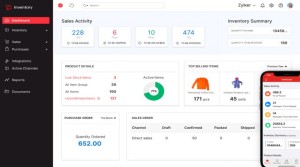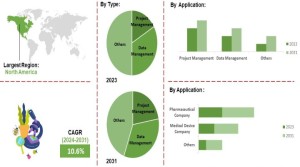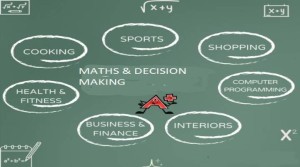Mathematics - The Superpower for Everyday Problem-Solving
Learn how math helps you solve problems in daily life, from counting toys to creating video games. See how math applies to the world around you.
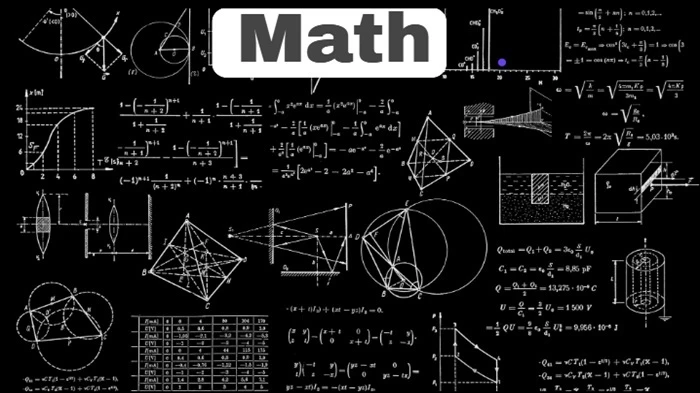
Math is like a superpower for understanding and solving problems related to numbers, shapes, patterns, and quantities. It helps use make sense of the world around us. Whether you're counting your toys, figuring out how much pizza to order, or designing an excellent video game, math is there to help you make sense of things. It's like a set of tools that you can use to explore, explain, and solve all sorts of everyday puzzles.
Branches of Mathematics
Algebra
Algebra is an ancient part of math that deals with numbers, shapes, and how things relate to each other. When we talk about algebra, we mean using letters and rules to work with numbers. It's not just about solving simple math problems but also about understanding abstract ideas. In math classes, you'll find algebra everywhere, with equations and formulas being a big part of it.
Algebra helps us solve problems involving unknown values, like figuring out interest rates or percentages at the bank. We use letters in algebra to represent these unknowns and rewrite equations to understand them better. In our daily lives, algebraic formulas help us find distances and volumes and even set prices for things. Algebra is all about expressing relationships and equations using letters or symbols. It's a tool we use to solve unknowns in various situations. There are different aspects of algebra, like basic algebra, exponents, simplifying expressions, polynomials, and quadratic equations. In order to solve quadratic equations, use a Quadratic Formula Calculator.

Branches of Algebra
Algebra is about dealing with unknown values, called variables. It has different parts, like elementary algebra, advanced algebra, abstract algebra, linear algebra, and commutative algebra.
- Elementary Algebra (Algebra 1)
This is where you start with the basics. It covers everyday math operations like addition, subtraction, multiplication, and division. Still, instead of numbers, you use letters like x, a, n, and y. Elementary algebra helps us understand the rules of arithmetic and the properties of numbers. Basic calculators are more helpful in this regard.
- Advanced Algebra (Algebra 2)
This is the next level after elementary algebra. It involves solving more complex equations and delves into topics like inequalities, matrices, systems of linear equations, graphing functions, and more. It's like the advanced version of algebra, where you deal with a broader range of mathematical concepts.
- Abstract Algebra
Abstract algebra is a branch that explores the fundamental truths of algebraic systems without focusing on specific operations. It deals with structures like fields, groups, rings, and vector spaces. It's a more theoretical and abstract side of algebra.
- Linear Algebra
Linear algebra studies linear equations, vector spaces, and matrices. It's used in both pure and applied mathematics, dealing with things like planes and lines. Linear algebra is widespread across different areas of math and is essential for understanding equations with transformation properties. To speed up your calculations regarding algebra, use the exponential calculator and log calculator in combination with a factor calculator.
- Commutative Algebra
This branch studies commutative rings and their ideals. It's crucial for algebraic number theory and algebraic geometry. Commutative algebra plays a significant role in various areas of mathematics, such as differential topology, invariant theory, order theory, and general topology.
Geometry
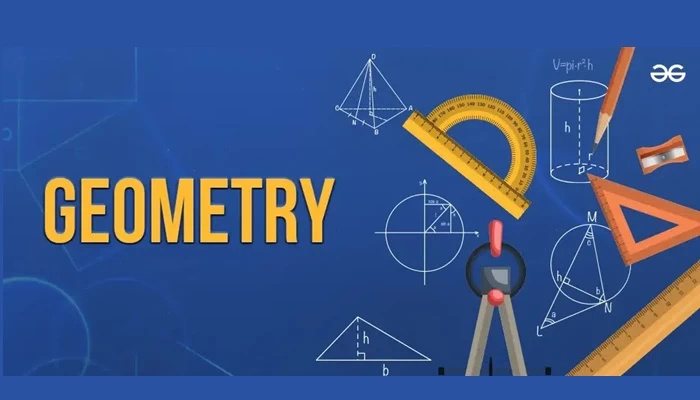
Geometry is a part of math that deals with shapes, sizes, angles, and dimensions of things we see every day. The word 'geometry' comes from Ancient Greek - 'Geo' means 'Earth', and 'metron' means 'measurement'. In Euclidean geometry, there are 2D shapes like triangles, squares, and circles, as well as 3D shapes like cubes and cones. The basic concepts involve points, lines, and planes, which are explained in coordinate geometry. Understanding different shapes in geometry helps us to calculate the area, perimeter, and volume of objects using calculators like the area calculator or volume calculator. While calculating things about circles, use a circle calculator in no time.
Geometry has various branches that focus on specific aspects. Algebraic Geometry deals with solving multi-variate polynomial equations and finds applications in cryptography and string theory. Discrete geometry studies the relative positions of simple geometric objects like points and lines. Differential geometry uses algebra and calculus to solve problems, including applications in physics, like general relativity. Euclidean Geometry studies plane and solid figures based on axioms and theorems, finding applications in computer science, modern math problem-solving, and crystallography. Convex Geometry explores convex shapes in Euclidean space, with applications in optimization and functional analysis in number theory.
Arithmetic

An intelligent guy named Carl Friedrich Gauss in 1801 figured out an excellent idea about numbers. He said that any number is more significant than one can be made by multiplying prime numbers together in just one way. Arithmetic is another name for this idea. Arithmetic is the fundamental of mathematics that includes the operations of numbers. The word comes from the Greek word 'arithmos', which means 'number'. When we have huge numbers that are too large to handle with a Basic calculator, we use a unique tool called a Big Number Calculator. This helps us add, subtract, or multiply large numbers without any problems. It's like a super-powered calculator for colossal math. What are the arithmetic operators?
- Adding things together (+)
- Taking things away (-)
- Multiplying things (x)
- Dividing things (÷)
Importance of Arithmetic Math
In our daily lives, arithmetic math plays a fundamental role in various practical situations. When we go grocery shopping, we rely on addition to calculate the total cost of our items and subtraction to stay within our budget. In the kitchen, arithmetic is essential for adjusting recipes, measuring ingredients, and determining cooking times in combination with a time calculator.
Budgeting finances on a budget calculator involves addition and subtraction to manage income and expenses, ensuring that we are spending appropriately. Time management through study time planner also hinges on arithmetic, as we add or subtract hours and minutes to schedule our day and set alarms for appointments.
Moreover, arithmetic finds application in diverse scenarios, such as travel planning, where we calculate distances on a distance calculator, travel times, and expenses, often involving multiplication and division. Home improvement projects require arithmetic for measuring spaces, calculating areas, and determining the amount of materials needed. Whether it's tracking fitness progress, calculating discounts while shopping, or managing DIY projects, arithmetic proves indispensable in problem-solving and decision-making across a wide range of everyday activities.
Combinatorics
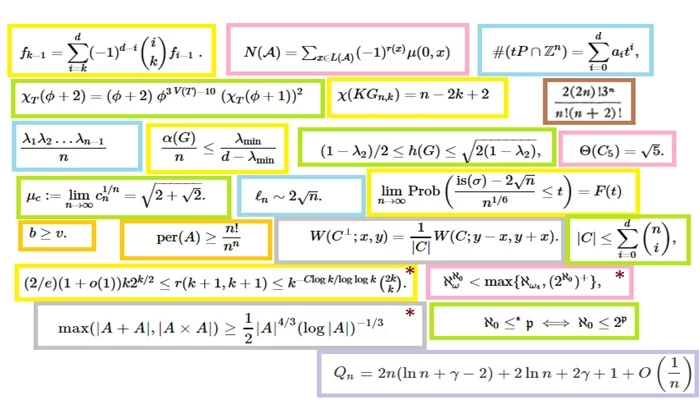
Combinatorics is a branch of math that looks at finite discrete structures. It's about studying combinations and permutations, ways of arranging or choosing elements from sets. Mathematicians use "Combinatorics" to talk about a more significant part of math called Discrete Mathematics. This is important in computer science, helping to create formulas and analyze algorithms. In this article, we'll dive into what combinatorics is, its features, formulas, and applications.
Some key features of combinatorics include counting structures of a given kind and size, figuring out when specific criteria can be met, and identifying the "greatest", "smallest", or "optimal" elements. When combinatorics connects with algebra, it's called algebraic combinatorics.
Now, let's talk about permutation and combination. Think of a fruit salad - the order of grapes, bananas, and apples doesn't matter. But, when it comes to a combination like a critical code (e.g. 475), the order is crucial - other combinations like 457 or 574 won't work. So, when order doesn't matter, it's a combination; when it does, it's a permutation.
Combinatorics finds applications in various fields like communication networks, cryptography, computational molecular biology, computer architecture, scientific discovery, languages, pattern analysis, simulation, databases, homeland security, and operations research. In simpler terms, combinatorics helps us understand and work with arrangements and choices in different areas of math and computer science.
Calculus
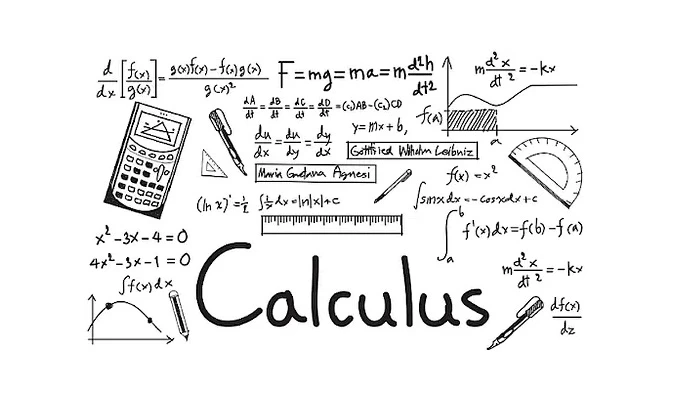
Calculus, an area of Mathematics pioneered by Newton and Leibniz, explores the concept of rate of change. It plays a crucial role in constructing mathematical models to derive optimal solutions. Calculus facilitates the comprehension of variations between values connected through a function. Key components of Calculus include differentiation, integration, limits, functions, and other essential topics.
Different Types of Calculus
There are two primary flavours of calculus - Differential Calculus and Integral Calculus. Both of them dive into how a tiny change in one thing affects another. These are the building blocks for a fancier math called "Analysis". Simply put, calculus deals with the nitty-gritty details of derivatives and integrals. It helps us understand changes between values linked by a function. Think of it like peeking into how things, like area, volume, speed, or acceleration, change.
- Basic Calculus
Basic calculus is like the beginner's guide. It's all about differentiation and integration. These concepts revolve around limits and functions. Differential calculus tells you how things change, while integral calculus helps you find stuff when you know how they're changing.
- Advanced Calculus
Once you've mastered the basics, there's advanced calculus. This includes things like infinite series, power series, and more. It's like applying the basic principles to fancier ideas. This helps us explore cool concepts like quadratic forms, vector fields, and continuous differentiability.
Where Does Calculus Fit in Real Life?
Calculus is a mathematical model that helps us analyze a system to find an optimal solution to predict the future. In real life, concepts of calculus play a major role, whether it is related to solving the area of complicated shapes, the safety of vehicles, evaluating survey data for business planning, credit card payment records, or finding the changing conditions of a system affect us, etc. Calculus is a language of physicians, economists, biologists, architects, medical experts, and statisticians, and they often use it. For example, Architects and engineers use concepts of calculus to determine the size and shape of the curves to design bridges, roads, tunnels, etc. Using calculus, some of the concepts are beautifully modelled, such as birth and death rates, radioactive decay, reaction rates, heat and light, motion, electricity, etc.
Probability and Statistics

In math, there are two important ideas called Probability and Statistics. Probability is about chances, like the likelihood of something happening. On the other hand, Statistics is more about how we deal with different kinds of information. It helps make complex data easy to understand. People usually learn about Probability and Statistics in school around Class 10, 11, or 12 when they are getting ready for exams. These concepts are briefly explained in your textbooks and notes. Nowadays, Statistics is widely used in jobs related to data science. Professionals use it to predict how a business might do in the future - like figuring out if a company will make a profit or have a loss.
What is Probability?
Probability is a way of expressing how likely it is for a particular outcome to occur in a random event. It's a way to quantify the chance of an event happening. For instance, if you toss a coin, the probability of getting a head is determined by the possible outcomes, which in this case are either a head or a tail. So, the probability of getting a head is 1/2, as there are two equally likely outcomes. In a broader sense, probability is a measure of the likelihood of an event, indicating the degree of certainty associated with its occurence. You can either calculate on a probability calculator or by using the following formula method.
P(E) = Number of Favorable Outcomes / Number of Total Outcomes
What is Statistics?
Statistics is like a detective tool for information. It helps us collect, analyze, and understand data in an organized way. You can use it for all kinds of things, from studying how many people live in a country to figuring out how the economy is doing. The statistics calculator is a handy tool for this.
People use statistics in different areas like sociology, psychology, geology, and even weather forecasting. The information we collect for analysis can be numbers (quantitative) or descriptions (qualitative). When it comes to numbers, there are two types - discrete, which have fixed values, and continuous, which have a range of possibilities.
Terms Used in Probability and Statistics
- Random Experiment
A random experiment is one where the outcome remains unpredictable until observed. Take throwing a dice, for instance - the result is uncertain beforehand. Any number from 1 to 6 could be the outcome, making it a random experiment.
- Sample Space
Imagine you're rolling a six-sided slice. Sample space is a fancy term for all the possible outcomes you could get from that role. In this case, the sample space is the set of all possible numbers you see after rolling the dice. So, if the dice have numbers 1 through 6, the sample space would be {1, 2, 3, 4, 5, 6}. It's essentially a way of listing all the potential results you could get from the random experiment, whether it's rolling a dice, flipping a coin, or any other chance-based activity.
Sample Space = {1, 2, 3, 4, 5, 6}
- Random Variables
Imagine you're conducting some random experiment, like rolling a die or flipping a coin. The outcomes of these experiments can be described using something called "random variables". Now, there are two main types of these random variables.
- Discrete Random Variables
These are like the outcomes you can count, like the number on a rolled die (1, 2, 3, 4, 5, 6) or the result of flipping a coin (heads or tails). The critical point here is that these variables can only take specific, separate values that you can easily list.
- Continuous Random Variables
These are different. Instead of specific, countable values, they can take on an infinite number of possibilities. Think of something like the height of a person or the exact time it takes for a reaction to occur. You can't list all the possible values because there are just too many, and they form a continuous range.
- Independent Event
When one event happening doesn't affect the likelihood of another event occuring, we call those events independent of each other. For instance, flipping a coin and rolling a die at the same time - the chance of getting a 'head' doesn't influence the chance of rolling a 6 on the die, and vice versa.
- Mean
The mean of a random variable represents the average of the potential values that may arise from a random experiment. Essentially, it reflects the anticipated outcome of the experiment when repeated numerous times or performed a certain number of times (n). This concept is alternatively referred to as the expectation of a random variable.
- Expected Value
The expected value represents the average or mean of a random variable in a given probability distribution. It's the anticipated value taken into account for a random experiment, and it goes by various names such as expectation, mathematical expectation, or the first moment. To illustrate, consider rolling a six-faced die - the expected value, in this case, would be the sum of all possible outcomes divided by the number of outcomes, resulting in an average value of 3.5.
Some Tips to Be Great At Math
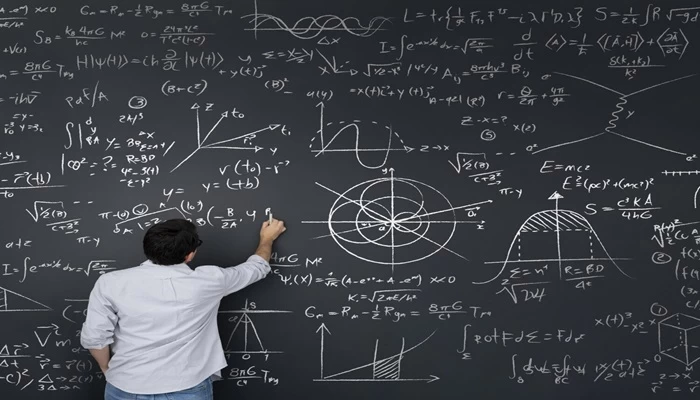
Practice Regularly
- Regular practice is crucial in improving math skills.
- Work on a variety of problems to reinforce concepts.
Understand the Basics
- Ensure a solid foundation by mastering fundamental concepts.
- Only move on to advanced topics with a firm grasp of the basics.
Seek Understanding, Not Memorization
- Understand the reasoning behind formulas and procedures.
- Avoid rote memorization; instead, focus on the logic.
Ask Questions
- Feel free to ask your teacher or peers for clarification.
- Engage in discussions to deepen your understanding.
Use Multiple Resources
- Utilize textbooks, online resources, and videos to gain different perspectives.
- Explore various learning materials to find what works best for you.
Teach Others
- Teaching a concept to someone else can reinforce your own understanding.
- Tutoring or helping classmates can enhance your skills.
Practice Mental Math
- Develop mental math skills for quick calculations.
- This improves overall numerical fluency.
Problem-Solving Approach
- Focus on problem-solving strategies rather than just finding answers.
- Understand the steps involved in reaching a solution.
Create a Positive Learning Environment
- Find a quiet and comfortable space to study.
- Minimize distractions to enhance concentration.
Use Technology Wisely
- Utilize calculators and mathematical software for complex calculations.
- Interactive apps and online platforms can make learning more engaging.
Review and Reflect
- Regularly review previous topics to reinforce learning.
- Reflect on mistakes and understand the reasons behind them.
Set Realistic Goals
- Break down larger goals into smaller, achievable tasks.
- Celebrate your achievements along the way.
Stay Positive and Persistent
- Believe in your ability to improve.
- Persistence is crucial; keep going despite challenges.
Join Math Clubs or Study Groups
- Collaborate with peers who share similar goals.
- Discussing problems with others can provide new insights.
Explore Real-World Applications
- Understand how math is applied in various fields.
- This can make the subject more interesting and relevant.
Mental Math
Mental math is like doing math in your head without using a calculator or writing things down. It's all about using your brain to quickly and accurately solve problems. When you practice mental math, you're giving your brain a good workout. It's like going to the gym but for your mind. It helps improve your concentration, memory, and problem-solving skills. Just like any exercise, the more you do it, the better you get.
Imagine you're out shopping and need to figure out how much things will cost before reaching the checkout. Mental math comes in handy here. It's like having a superpower that helps you calculate stuff on the spot. So, mental math is not just about numbers; it's about keeping your brain sharp and ready for action. It's an incredible skill to have, and the more you practice, the more your brain flexes its muscles.
Conversely, individuals lacking strong mathematical abilities have the option to leverage various calculators to enhance their calculations and save time. For instance, a root calculator can be employed when tackling quadratic equations, and a standard deviation calculator proves helpful when dealing with dispersions in calculus.
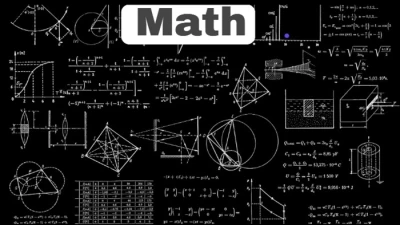
Math is like a superpower for understanding and solving problems related to numbers, shapes, patterns, and quantities. It helps use make sense of the world around us. Whether you're counting your toys, figuring out how much pizza to order, or designing an excellent video game, math is there to help you make sense of things. It's like a set of tools that you can use to explore, explain, and solve all sorts of everyday puzzles.
Branches of Mathematics
Algebra
Algebra is an ancient part of math that deals with numbers, shapes, and how things relate to each other. When we talk about algebra, we mean using letters and rules to work with numbers. It's not just about solving simple math problems but also about understanding abstract ideas. In math classes, you'll find algebra everywhere, with equations and formulas being a big part of it.
Algebra helps us solve problems involving unknown values, like figuring out interest rates or percentages at the bank. We use letters in algebra to represent these unknowns and rewrite equations to understand them better. In our daily lives, algebraic formulas help us find distances and volumes and even set prices for things. Algebra is all about expressing relationships and equations using letters or symbols. It's a tool we use to solve unknowns in various situations. There are different aspects of algebra, like basic algebra, exponents, simplifying expressions, polynomials, and quadratic equations. In order to solve quadratic equations, use a Quadratic Formula Calculator.
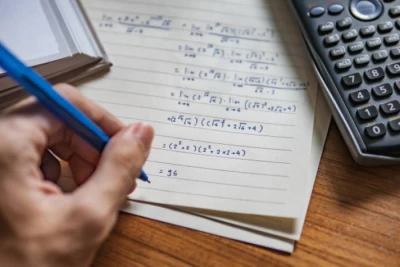
Branches of Algebra
Algebra is about dealing with unknown values, called variables. It has different parts, like elementary algebra, advanced algebra, abstract algebra, linear algebra, and commutative algebra.
- Elementary Algebra (Algebra 1)
This is where you start with the basics. It covers everyday math operations like addition, subtraction, multiplication, and division. Still, instead of numbers, you use letters like x, a, n, and y. Elementary algebra helps us understand the rules of arithmetic and the properties of numbers. Basic calculators are more helpful in this regard.
- Advanced Algebra (Algebra 2)
This is the next level after elementary algebra. It involves solving more complex equations and delves into topics like inequalities, matrices, systems of linear equations, graphing functions, and more. It's like the advanced version of algebra, where you deal with a broader range of mathematical concepts.
- Abstract Algebra
Abstract algebra is a branch that explores the fundamental truths of algebraic systems without focusing on specific operations. It deals with structures like fields, groups, rings, and vector spaces. It's a more theoretical and abstract side of algebra.
- Linear Algebra
Linear algebra studies linear equations, vector spaces, and matrices. It's used in both pure and applied mathematics, dealing with things like planes and lines. Linear algebra is widespread across different areas of math and is essential for understanding equations with transformation properties. To speed up your calculations regarding algebra, use the exponential calculator and log calculator in combination with a factor calculator.
- Commutative Algebra
This branch studies commutative rings and their ideals. It's crucial for algebraic number theory and algebraic geometry. Commutative algebra plays a significant role in various areas of mathematics, such as differential topology, invariant theory, order theory, and general topology.
Geometry
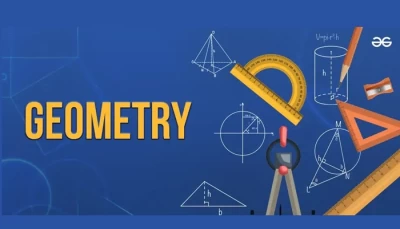
Geometry is a part of math that deals with shapes, sizes, angles, and dimensions of things we see every day. The word 'geometry' comes from Ancient Greek - 'Geo' means 'Earth', and 'metron' means 'measurement'. In Euclidean geometry, there are 2D shapes like triangles, squares, and circles, as well as 3D shapes like cubes and cones. The basic concepts involve points, lines, and planes, which are explained in coordinate geometry. Understanding different shapes in geometry helps us to calculate the area, perimeter, and volume of objects using calculators like the area calculator or volume calculator. While calculating things about circles, use a circle calculator in no time.
Geometry has various branches that focus on specific aspects. Algebraic Geometry deals with solving multi-variate polynomial equations and finds applications in cryptography and string theory. Discrete geometry studies the relative positions of simple geometric objects like points and lines. Differential geometry uses algebra and calculus to solve problems, including applications in physics, like general relativity. Euclidean Geometry studies plane and solid figures based on axioms and theorems, finding applications in computer science, modern math problem-solving, and crystallography. Convex Geometry explores convex shapes in Euclidean space, with applications in optimization and functional analysis in number theory.
Arithmetic

An intelligent guy named Carl Friedrich Gauss in 1801 figured out an excellent idea about numbers. He said that any number is more significant than one can be made by multiplying prime numbers together in just one way. Arithmetic is another name for this idea. Arithmetic is the fundamental of mathematics that includes the operations of numbers. The word comes from the Greek word 'arithmos', which means 'number'. When we have huge numbers that are too large to handle with a Basic calculator, we use a unique tool called a Big Number Calculator. This helps us add, subtract, or multiply large numbers without any problems. It's like a super-powered calculator for colossal math. What are the arithmetic operators?
- Adding things together (+)
- Taking things away (-)
- Multiplying things (x)
- Dividing things (÷)
Importance of Arithmetic Math
In our daily lives, arithmetic math plays a fundamental role in various practical situations. When we go grocery shopping, we rely on addition to calculate the total cost of our items and subtraction to stay within our budget. In the kitchen, arithmetic is essential for adjusting recipes, measuring ingredients, and determining cooking times in combination with a time calculator.
Budgeting finances on a budget calculator involves addition and subtraction to manage income and expenses, ensuring that we are spending appropriately. Time management through study time planner also hinges on arithmetic, as we add or subtract hours and minutes to schedule our day and set alarms for appointments.
Moreover, arithmetic finds application in diverse scenarios, such as travel planning, where we calculate distances on a distance calculator, travel times, and expenses, often involving multiplication and division. Home improvement projects require arithmetic for measuring spaces, calculating areas, and determining the amount of materials needed. Whether it's tracking fitness progress, calculating discounts while shopping, or managing DIY projects, arithmetic proves indispensable in problem-solving and decision-making across a wide range of everyday activities.
Combinatorics

Combinatorics is a branch of math that looks at finite discrete structures. It's about studying combinations and permutations, ways of arranging or choosing elements from sets. Mathematicians use "Combinatorics" to talk about a more significant part of math called Discrete Mathematics. This is important in computer science, helping to create formulas and analyze algorithms. In this article, we'll dive into what combinatorics is, its features, formulas, and applications.
Some key features of combinatorics include counting structures of a given kind and size, figuring out when specific criteria can be met, and identifying the "greatest", "smallest", or "optimal" elements. When combinatorics connects with algebra, it's called algebraic combinatorics.
Now, let's talk about permutation and combination. Think of a fruit salad - the order of grapes, bananas, and apples doesn't matter. But, when it comes to a combination like a critical code (e.g. 475), the order is crucial - other combinations like 457 or 574 won't work. So, when order doesn't matter, it's a combination; when it does, it's a permutation.
Combinatorics finds applications in various fields like communication networks, cryptography, computational molecular biology, computer architecture, scientific discovery, languages, pattern analysis, simulation, databases, homeland security, and operations research. In simpler terms, combinatorics helps us understand and work with arrangements and choices in different areas of math and computer science.
Calculus
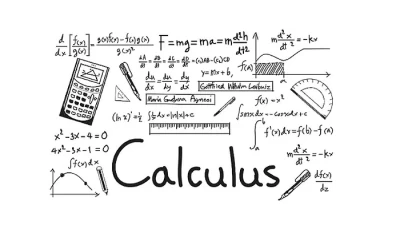
Calculus, an area of Mathematics pioneered by Newton and Leibniz, explores the concept of rate of change. It plays a crucial role in constructing mathematical models to derive optimal solutions. Calculus facilitates the comprehension of variations between values connected through a function. Key components of Calculus include differentiation, integration, limits, functions, and other essential topics.
Different Types of Calculus
There are two primary flavours of calculus - Differential Calculus and Integral Calculus. Both of them dive into how a tiny change in one thing affects another. These are the building blocks for a fancier math called "Analysis". Simply put, calculus deals with the nitty-gritty details of derivatives and integrals. It helps us understand changes between values linked by a function. Think of it like peeking into how things, like area, volume, speed, or acceleration, change.
- Basic Calculus
Basic calculus is like the beginner's guide. It's all about differentiation and integration. These concepts revolve around limits and functions. Differential calculus tells you how things change, while integral calculus helps you find stuff when you know how they're changing.
- Advanced Calculus
Once you've mastered the basics, there's advanced calculus. This includes things like infinite series, power series, and more. It's like applying the basic principles to fancier ideas. This helps us explore cool concepts like quadratic forms, vector fields, and continuous differentiability.
Where Does Calculus Fit in Real Life?
Calculus is a mathematical model that helps us analyze a system to find an optimal solution to predict the future. In real life, concepts of calculus play a major role, whether it is related to solving the area of complicated shapes, the safety of vehicles, evaluating survey data for business planning, credit card payment records, or finding the changing conditions of a system affect us, etc. Calculus is a language of physicians, economists, biologists, architects, medical experts, and statisticians, and they often use it. For example, Architects and engineers use concepts of calculus to determine the size and shape of the curves to design bridges, roads, tunnels, etc. Using calculus, some of the concepts are beautifully modelled, such as birth and death rates, radioactive decay, reaction rates, heat and light, motion, electricity, etc.
Probability and Statistics

In math, there are two important ideas called Probability and Statistics. Probability is about chances, like the likelihood of something happening. On the other hand, Statistics is more about how we deal with different kinds of information. It helps make complex data easy to understand. People usually learn about Probability and Statistics in school around Class 10, 11, or 12 when they are getting ready for exams. These concepts are briefly explained in your textbooks and notes. Nowadays, Statistics is widely used in jobs related to data science. Professionals use it to predict how a business might do in the future - like figuring out if a company will make a profit or have a loss.
What is Probability?
Probability is a way of expressing how likely it is for a particular outcome to occur in a random event. It's a way to quantify the chance of an event happening. For instance, if you toss a coin, the probability of getting a head is determined by the possible outcomes, which in this case are either a head or a tail. So, the probability of getting a head is 1/2, as there are two equally likely outcomes. In a broader sense, probability is a measure of the likelihood of an event, indicating the degree of certainty associated with its occurence. You can either calculate on a probability calculator or by using the following formula method.
P(E) = Number of Favorable Outcomes / Number of Total Outcomes
What is Statistics?
Statistics is like a detective tool for information. It helps us collect, analyze, and understand data in an organized way. You can use it for all kinds of things, from studying how many people live in a country to figuring out how the economy is doing. The statistics calculator is a handy tool for this.
People use statistics in different areas like sociology, psychology, geology, and even weather forecasting. The information we collect for analysis can be numbers (quantitative) or descriptions (qualitative). When it comes to numbers, there are two types - discrete, which have fixed values, and continuous, which have a range of possibilities.
Terms Used in Probability and Statistics
- Random Experiment
A random experiment is one where the outcome remains unpredictable until observed. Take throwing a dice, for instance - the result is uncertain beforehand. Any number from 1 to 6 could be the outcome, making it a random experiment.
- Sample Space
Imagine you're rolling a six-sided slice. Sample space is a fancy term for all the possible outcomes you could get from that role. In this case, the sample space is the set of all possible numbers you see after rolling the dice. So, if the dice have numbers 1 through 6, the sample space would be {1, 2, 3, 4, 5, 6}. It's essentially a way of listing all the potential results you could get from the random experiment, whether it's rolling a dice, flipping a coin, or any other chance-based activity.
Sample Space = {1, 2, 3, 4, 5, 6}
- Random Variables
Imagine you're conducting some random experiment, like rolling a die or flipping a coin. The outcomes of these experiments can be described using something called "random variables". Now, there are two main types of these random variables.
- Discrete Random Variables
These are like the outcomes you can count, like the number on a rolled die (1, 2, 3, 4, 5, 6) or the result of flipping a coin (heads or tails). The critical point here is that these variables can only take specific, separate values that you can easily list.
- Continuous Random Variables
These are different. Instead of specific, countable values, they can take on an infinite number of possibilities. Think of something like the height of a person or the exact time it takes for a reaction to occur. You can't list all the possible values because there are just too many, and they form a continuous range.
- Independent Event
When one event happening doesn't affect the likelihood of another event occuring, we call those events independent of each other. For instance, flipping a coin and rolling a die at the same time - the chance of getting a 'head' doesn't influence the chance of rolling a 6 on the die, and vice versa.
- Mean
The mean of a random variable represents the average of the potential values that may arise from a random experiment. Essentially, it reflects the anticipated outcome of the experiment when repeated numerous times or performed a certain number of times (n). This concept is alternatively referred to as the expectation of a random variable.
- Expected Value
The expected value represents the average or mean of a random variable in a given probability distribution. It's the anticipated value taken into account for a random experiment, and it goes by various names such as expectation, mathematical expectation, or the first moment. To illustrate, consider rolling a six-faced die - the expected value, in this case, would be the sum of all possible outcomes divided by the number of outcomes, resulting in an average value of 3.5.
Some Tips to Be Great At Math
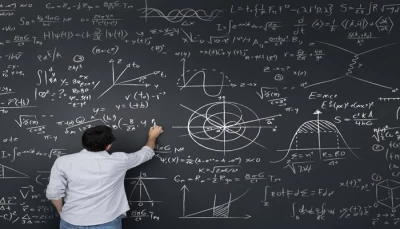
Practice Regularly
- Regular practice is crucial in improving math skills.
- Work on a variety of problems to reinforce concepts.
Understand the Basics
- Ensure a solid foundation by mastering fundamental concepts.
- Only move on to advanced topics with a firm grasp of the basics.
Seek Understanding, Not Memorization
- Understand the reasoning behind formulas and procedures.
- Avoid rote memorization; instead, focus on the logic.
Ask Questions
- Feel free to ask your teacher or peers for clarification.
- Engage in discussions to deepen your understanding.
Use Multiple Resources
- Utilize textbooks, online resources, and videos to gain different perspectives.
- Explore various learning materials to find what works best for you.
Teach Others
- Teaching a concept to someone else can reinforce your own understanding.
- Tutoring or helping classmates can enhance your skills.
Practice Mental Math
- Develop mental math skills for quick calculations.
- This improves overall numerical fluency.
Problem-Solving Approach
- Focus on problem-solving strategies rather than just finding answers.
- Understand the steps involved in reaching a solution.
Create a Positive Learning Environment
- Find a quiet and comfortable space to study.
- Minimize distractions to enhance concentration.
Use Technology Wisely
- Utilize calculators and mathematical software for complex calculations.
- Interactive apps and online platforms can make learning more engaging.
Review and Reflect
- Regularly review previous topics to reinforce learning.
- Reflect on mistakes and understand the reasons behind them.
Set Realistic Goals
- Break down larger goals into smaller, achievable tasks.
- Celebrate your achievements along the way.
Stay Positive and Persistent
- Believe in your ability to improve.
- Persistence is crucial; keep going despite challenges.
Join Math Clubs or Study Groups
- Collaborate with peers who share similar goals.
- Discussing problems with others can provide new insights.
Explore Real-World Applications
- Understand how math is applied in various fields.
- This can make the subject more interesting and relevant.
Mental Math
Mental math is like doing math in your head without using a calculator or writing things down. It's all about using your brain to quickly and accurately solve problems. When you practice mental math, you're giving your brain a good workout. It's like going to the gym but for your mind. It helps improve your concentration, memory, and problem-solving skills. Just like any exercise, the more you do it, the better you get.
Imagine you're out shopping and need to figure out how much things will cost before reaching the checkout. Mental math comes in handy here. It's like having a superpower that helps you calculate stuff on the spot. So, mental math is not just about numbers; it's about keeping your brain sharp and ready for action. It's an incredible skill to have, and the more you practice, the more your brain flexes its muscles.
Conversely, individuals lacking strong mathematical abilities have the option to leverage various calculators to enhance their calculations and save time. For instance, a root calculator can be employed when tackling quadratic equations, and a standard deviation calculator proves helpful when dealing with dispersions in calculus.
Conversation
Latest Blogs
© Blog CoolCalculator, Explore CoolCalculator, your destination for the latest insights, tips, and updates on the world of online calculators. Stay informed and make your calculations smarter with our blog. ,
Designed
by Saad Media Team , Team Lead M.Rizwan Akhtar




